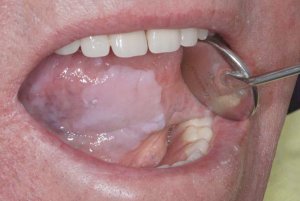
What is Oral Leukoplakia
Oral Leukoplakia is a condition in which thickened, white patches form on the gums, floor of the mouth, inner lining of the cheeks and sometimes on or under the tongue. These patches can't be scraped off easily.
People with compromised immune systems, sometimes develop an unusual form of the disorder called Oral Hairy Leukoplakia.
 Oral leukoplakia is usually not painful. However, leukoplakia symptoms should not be ignored. The condition is considered to be mostly benign (non-cancerous),
but in a small percentage of cases leukoplakia patches show early signs of cancer. While oral leukoplakia lesions rarely develop into cancer, many cancers of the mouth are found adjacent to areas of leukoplakia.
Oral leukoplakia is usually not painful. However, leukoplakia symptoms should not be ignored. The condition is considered to be mostly benign (non-cancerous),
but in a small percentage of cases leukoplakia patches show early signs of cancer. While oral leukoplakia lesions rarely develop into cancer, many cancers of the mouth are found adjacent to areas of leukoplakia.
Causes of Leukoplakia
The actual mechanism of what causes leukoplakia is unknown. However there are certain factors that have been linked with the development of leukoplakia, most of them related with the mouth's reaction to chronic irritation of the mucous membranes. The possible causes of leukoplakia include :
- Smoking and chewing tobacco. Epidemiological data show that tobacco use is related with most cases of leukoplakia. People who chew tobacco develop leukoplakia at a higher rate and usually at the exact spot where they hold the tobacco against their cheeks. Another evidence showing that tobacco is among leukoplakia causes is that the condition improves or disappears some time after stopping its use.
- Long-term alcohol use is also associated with leukoplakia, due to long term irritation of the mouth.
- Mechanical irritation, caused by rough edges of teeth, fillings, crowns or dentures rubbing against the cheeks or gums, is another cause of leukoplakia.
- Oral cancer. In a small percentage of cases, leukoplakia proves to be a pre-malignant lesion.
Other conditions mentioned as potential causes of oral leukoplakia are :
- Habits such as chewing pens, biting your lip or tooth grinding
- Sun exposure on the lips
- Using dental products that contain sanguinarine
- Human papilloma virus infection
Candida albicans, the fungus that causes oral thrush, is usually found in the leukoplakia patches. But it is not clear if its presence is the cause of leukoplakia or just a secondary effect of this condition.
Symptoms of Leukoplakia
Leukoplakia symptoms may appear at any age, but they are especially common in the elderly. More men than women develop oral leukoplakia with a male-to-female ratio of 2:1.
Initially oral leukoplakia symptoms appear as flat, gray or gray-white plaques on the gums, floor of the mouth, inside the cheeks and sometimes on or under the tongue. These sores, in a period of weeks or months, slowly develop into white patches with a thick, roughened or wrinkled texture and hardened surface. The white patches are not scraped off easily, like those in oral thrush, which helps to differentiate the two conditions.
Leukoplakia usually does not cause other symptoms. It is painless, but the patches in a few cases can become sensitive to touch, heat or spicy foods. If raised red lesions are present (erythroplakia), there is increased chance of a pre-cancerous condition.
Screening and diagnosis of oral leukoplakia
Oral Leukoplakia is normally diagnosed by examining the white patches in the mouth or the fuzzy manifestation of hairy leukoplakia on the tongue, after excluding other diseases that could cause similar symptoms, such as oral thrush.
Leukoplakia symptoms can be an early sign of oral cancer. To exclude this possibility, dentists remove a small tissue sample from the patch for analysis (biopsy). The sample will be examined for cancerous cells.
You should allways visit a dentist if you notice any sign of persistent abnormality in your mouth. Many diseases such as cancer, HIV/AIDS and others cause symptoms of oral leukoplakia.
Oral Leukoplakia Treatment
Usually all that is needed for the treatment of oral leukoplakia is just to remove the source of the irritation.
- If leukoplakia is caused by a rough edge of a tooth, filling, or crown or by a denture that does not fit properly, the surface should be smoothed and the dental appliances repaired.
- For most people, changing life habits by stopping smoking or alcohol consumption clears the condition in a few weeks or months without any permanent damage to the mouth tissues.
- If removing the irritating factors isn't effective in clearing the patches, leukoplakia treatment may include surgical removal and/or medication applications to the affected areas. A biopsy should be conducted (if not already done during diagnosis).
- A general dentist or an oral surgeon can surgically remove the leukoplakic patches using a scalpel, a laser or a cryoprobe, under local anesthesia. Follow-up is necessary after surgical removal because recurrences are frequent.
- Repeat biopsies may be necessary in some cases where there is a significant risk of cancer or changes in the size, color or texture of the leukoplakia.
- Retinoids - derivatives of vitamin A that are used to treat severe acne and other skin conditions - appear to be effective for tratment of leukoplakia, but unfortunately they cause side effects, even when used topically. Some research has also shown that vitamin E (alpha-tocopherol) and Beta carotene, (an antioxidant that's converted to vitamin A) may reduce the lesions associated with leukoplakia.
 Regardless of the selected leukoplakia treatment, your mouth should be clinically monitored periodically by your physician or dentist.
Many cases of oral cancer develop in mouth areas adjacent to areas of leukoplakia or in sites previously treated for leukoplakia, and the patches themselves may show cancerous changes.
Leukoplakia that contains pre-cancerous or cancerous cells on a biopsy should be removed by surgery. The prognosis will depend on the type and extent of the cancer.
Regardless of the selected leukoplakia treatment, your mouth should be clinically monitored periodically by your physician or dentist.
Many cases of oral cancer develop in mouth areas adjacent to areas of leukoplakia or in sites previously treated for leukoplakia, and the patches themselves may show cancerous changes.
Leukoplakia that contains pre-cancerous or cancerous cells on a biopsy should be removed by surgery. The prognosis will depend on the type and extent of the cancer.
Prevention of Oral Leukoplakia
Prevent leukoplakia by eliminating any irritating factors for the mouth. The following actions may help :
- Stop using tobacco products. Use of tobacco is directly related to many other diseases besides leukoplakia and oral cancer. Stopping its use will help you not only to prevent leukoplakia but will also promote your overall body health.
- Avoid or limit alcohol consumption. Combining alcohol and smoking greatly increases your risk of both leukoplakia and oral cancer because alcohol makes it easier for the harmful chemicals in tobacco to penetrate the tissues in your mouth.
- If you use dentures, maintain them properly and ensure that they are well fitted to your mouth. Stop any oral habits that could cause irritation. Have your dentist smooth any rough edges on fillings, crowns or natural teeth to prevent irritation.
- Eat plenty of fresh fruits and vegetables. These are rich in antioxidants such as beta carotene, which reduce the risk of leukoplakia. Carrots, squash, pumpkins, spinach, and cantaloupe are food sources rich in beta-carotenes.
- Regular dental exams can detect oral leukoplakia early, which is extremely important for succesful treatment if the lesion contains cancerous cells. related link (external) for oral leukoplakia
![]() The cost involved with dental treatments can be significant and many patients may not afford it if they are not covered by their dental insurance.
Learn how to choose a dental insurance plan that will provide the best dental treatment to you and your family.
The cost involved with dental treatments can be significant and many patients may not afford it if they are not covered by their dental insurance.
Learn how to choose a dental insurance plan that will provide the best dental treatment to you and your family.



